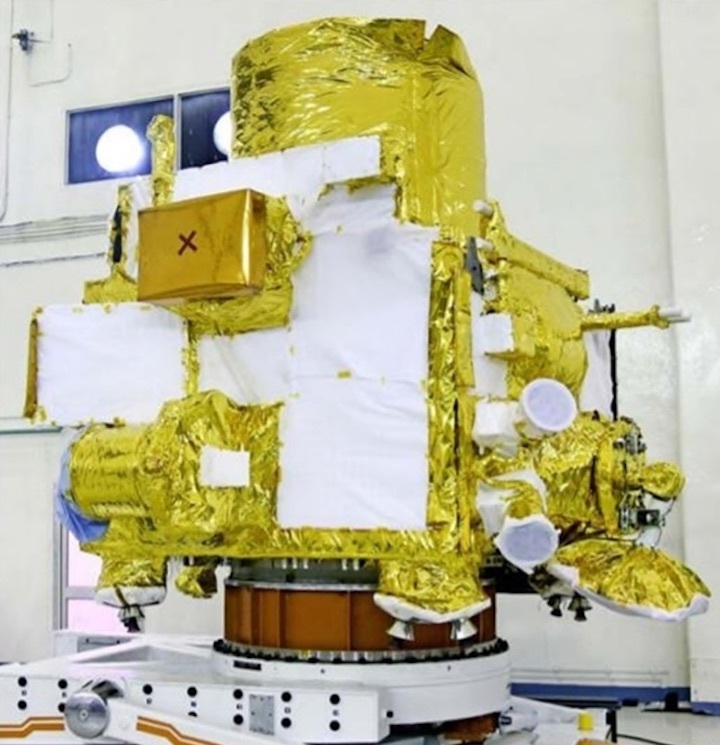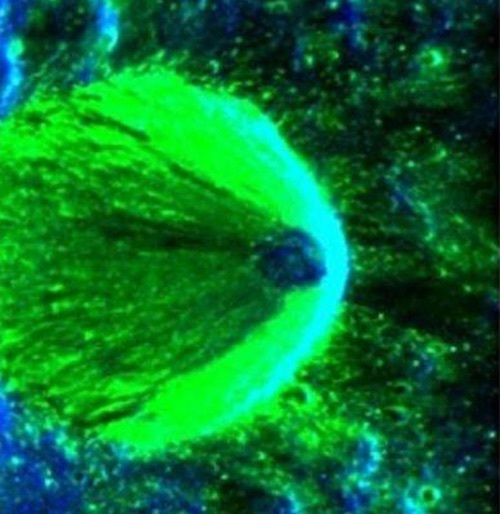10.09.2021
Chandrayaan-2 pointed to the distribution of most possible locations for the existence of water-ice on the lunar pole.

In a major achievement for Chandrayaan-2, one of the eight payloads onboard the orbiter has confirmed the presence of water ice in the permanently shadowed regions on the Moon. The latest discovery was revealed by the Indian Space and Research Organisation (Isro) in the new science data set released to mark two years of the lunar mission.
"The permanently shadowed regions (PSRs) in Lunar poles are reported to contain water-ice of various concentrations mixed with the lunar regolith," Isro said.
The discovery confirms the earlier radar-based studies of the lunar polar region for the presence of water-ice. The observation was conducted by the Dual Frequency Synthetic Aperture Radar (DFSAR), one of the eight instruments on the Chandrayaan-2 orbiter, which is capable of peering inside the lunar surface up to a few meters depth.
"DFSAR instrument on Chandrayaan-2 is the first-ever fully polarimetric dual-frequency imaging radar system in lunar orbit and is capable of probing these regions up to a few meters depth with full scattering matrix information, unlike its predecessors like CH-1 MiniSAR and LRO-MiniRF," Isro said in the newly released data.
WATER-ICE ON LUNAR POLES
Chandrayaan-2 pointed to the distribution of most possible locations for the existence of water-ice mixed with lunar regolith within the permanently shadowed regions of Peary crater in the Lunar North Pole. The spacecraft also managed to observe few potential “dirty ice” patches within the Cabeus’s crater floor, which is located near the South Pole of the Moon and is the impact site of the Lunar Crater Observation and Sensing Satellite (LCROSS) experiment in 2009.

Instruments onboard Chandrayaa-2 orbiters confirmed the presence of hydroxyl and water molecules on the Moon. (Photo: Isro)
Patchy dirty ice includes ice crystals that are mixed with regolith from the moon's surface, unlike continuous ice sheets. "Spectral measurements of the LCROSS ejecta plume detected the presence of water and hydroxyl along with the presence of a number of other volatile species, including carbon dioxide, light hydrocarbons, ammonia, and sulfur-bearing species," Isro said, however, DFSAR analysis indicated "no presence of thick, pure water ice deposits within the top 2-3 meters of the surface" in either the permanently shadowed or the sunlit portion of the Cabeus interior analyzed in this work.
Isro is now studying this region for further characterisation of these icy patches.
WHAT IS PERMANENTLY SHADOWED REGION OF THE MOON?
The permanently shadowed regions of the Moon are lurking in the craters of the lunar south pole that do not receive any sunlight throughout the year. These areas have not seen a single ray of sun in over two billion years. According to Nasa, "they appear dark because unlike on the Earth, the axis of the Moon is nearly perpendicular to the direction of the sun's light. The result is that the bottoms of certain craters are never pointed toward the Sun, with some remaining dark for over two billion years."

Studying these dark regions has always remained a challenge with several countries attempting missions to the dark side. While China has succeeded in landing a rover on this polar region,Isro's Chandrayaan-2 mission crash-landed on the surface two years ago. However, Nasa has managed to map this region using Lunar Reconnaissance Orbiter.
HISTORY OF DISCOVERIES BY CHANDRAYAAN
Even after it crash-landed on the lunar surface, the Chandrayaan-2 is delivering key observations about the Moon thanks to its orbiter, which has now completed 9,000 orbits. Scientists using the data obtained from the Imaging Infrared Spectrometer (IIRS) had also confirmed the unambiguous detection of OH (hydroxyl) and H2O (water) signatures. The instrument collects information from the Moon's electromagnetic spectrum, to understand the mineral composition of the natural satellite.
The signatures were found on the Moon between 29 degrees north and 62 degrees north latitude and researchers estimate that the brighter sunlit highland regions at higher latitudes of the Moon have higher hydroxyl or possibly water molecules.
Not just the Moon, the Chandrayaan-2 has also led to studies around the Sun, identifying new developments on the hot outermost layer of the bright star known as Corona. The spacecraft found abundances of magnesium, aluminium and silicon in the solar corona and observed around 100 microflares, providing new insights about coronal mass heating.
Isro, which had discovered water on the moon with Chandrayaan-1, is now in preparation to launch the third mission part of the Chandrayaan series, which will use the orbiter hovering over the Moon as it studies the lunar surface.
Quelle: INDIA TODAY
+++
ISRO Chandrayaan-2 Detects Presence Of Water Ice On Moon’s Polar Regions
ISRO scientists revealed that its Chandrayaan-2 spacecraft that recently completed its second anniversary has picked up traces of water ice in the Permanently Shadowed Regions of the Moon.
This was revealed in a two-day online lunar science workshop organised by ISRO from September 6 to 7.
To the uninitiated, Permanently Shadowed Regions are essentially the northern and southern poles of the moon that get zero sunlight, making them the coldest regions on the lunar surface.
ISRO Chief, K Sivan revealed that Chandrayaan-2 spacecraft is loaded with Dual Frequency Synthetic Aperture Radar that maps surfaces using measurements of electrical properties of materials and can differentiate between the lunar and the ice surface.

Quelle: INDIA TIMES
